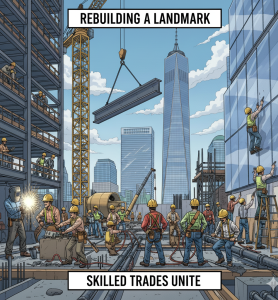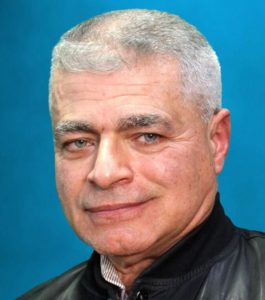By: Mike Porcelli
This week we remember the loss of our city’s most iconic landmark of the 20th Century, and mourn the loss of the thousands of lives taken that day 21 years ago. As we recall the destruction of the World Trade Center, think about what it took to build that structure six decades ago.

GEMINI-AI depicts the rebuilding of a great New York landmark
Construction of the original Towers was a massive undertaking that required the combined skills of tens-of-thousands of workers in dozens of trades, who made history by developed new building materials and construction techniques. Ironworkers erected the skeleton, as Welders joined thousands of the beams and columns together, Metal & Glass trades installed the facade, Electricians pulled thousands of miles of wires, and Plumbers & Steamfitters fabricated water, heating, and cooling systems. Work that could not be possible without skilled Crane Operators who lifted the heavy beams, materials, and machinery to heights never before seen.
The thousands of skilled workers who made the Twin-Towers possible, learned their skills in the mid-20th Century’s excellent vocational education programs that I grew up with. Replacing the Twin-Towers with the Freedom Tower, suffered from labor shortages caused by the loss of many of those great secondary and post- secondary education options.
It’s universally agreed that skilled trades are losing workers each year as growing numbers of aging tradesmen leave the workforce and schools produce fewer and fewer new replacements. Mike Rowe constantly cites the statistic that there are on average, only two new tradesmen for five that leave, and this “BAD-MATH,” is NOT sustainable.
I asked AI to reflect on the number of workers who built the Freedom Tower. It replied that approximately 9,000 full-time Steelworkers, Masons, Electricians, Plumbers, Pipefitters, Sprinkler Fitters, Carpenters, Plasterers, painters, and many other skilled titles, including the Crane Operators who made the structure rise again, were needed annually during the main construction phase. Once the tower was erected, thousands of other tradesmen were needed to finish and decorate all the tenant spaces. Many complained about the amount of time the reconstruction took. At least some of that delay may have been due to the growing shortage of tradesmen. Will that shortage hamper future projects?
AI suggested this: “Despite robust demand outlook, the industry faces a persistent and multi-faceted labor shortage. The current workforce, while highly diverse, is aging, and efforts to attract a new generation of workers are constrained by a public perception gap and declining unionization rates. To meet the projected demand, strategic, coordinated efforts are required from government, industry, and educational institutions to invest in training, streamline regulatory processes, and champion the skilled trades as a viable and lucrative career path…”ABSOLUTELY!!!
MAKE THAT INVESTMENT SO OUR ECONOMY REMAINS VIABLE… DO IT NOW, BEFORE WE CAN’T BUILD ANYTHING ELSE IN THE FUTURE!

***
Academic & Trade Education are Two Sides of a Coin.
This column explores the impact of CTE programs on students, society, and the economy.
Mike Porcelli: life-long mechanic, adjunct professor, and host of Autolab Radio, is committed to restoring trade education in schools before it’s too late. https://www.linkedin.com/in/mike-porcelli-master-mechanic-allasecerts/.


